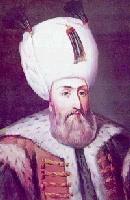Suleiman the Magnificent
|
|
Suleiman I (November 6, 1494 – September 5/6, 1566); in Turkish Süleyman, (nicknamed 'the Magnificent' in Europe and 'the Lawgiver' in the Islamic World, in Turkish 'Kanuni') was the sultan of the Ottoman Empire from 1520 to 1566 and successor to Selim I. He was born at Trabzon, Turkey.
The Ottoman Empire reached its zenith and became a world power during his reign. Although the empire continued to expand one century after his death, this period was followed by a very long decline.
At the age of seven he was sent to study science, history, literature, theology, and military techniques in the schools of the Istanbul palace. His early experience of government was as governor of several provinces, most notably Bolu in northern Anatolia, and his mother's homeland of Kaffa in Crimea at the age of 15.
Achievements
After succeeding his father on his death, Suleyman began a series of military conquests, starting with the capture of Belgrade in 1521. In 1522 he captured Rhodes after a siege, allowing the Knights of St. John to evacuate to Malta.
On August 29, 1526 Suleyman defeated Louis II of Hungary at the Battle of Mohács, occupying most of Hungary before giving it to John Zapolya, the prince of Transylvania, to govern. Charles V, Holy Roman Emperor and his brother Ferdinand, Archduke of Austria retook Hungary, in response to which Süleyman twice tried to re-invade, twice being beaten by the weather after reaching Vienna in 1529 and 1532. In 1533 a treaty was signed with Ferdinand, splitting Hungary between the Hapsburgs and Zapolya. On Zapolya's death, Ferdinand was left the Hungarian territories, prompting Süleyman to annex Hungary, resulting in several struggles and peace treaties restoring the status-quo.
In the following two decades, huge territories of North Africa west to Morocco and all Middle East north to Persia were annexed. This quick expansion was associated with naval dominance for a short period in the Mediterranean Sea, Red Sea and Persian Gulf. In 1562 he conquered Transylvania. He was not so successful in 1565 when the Knights of Malta succeeded in lifting the Siege of Malta, which began on May 18 and lasted until September 8.
While he may have been seen as dangerous to the outside world, he was known as a fair ruler within the empire, fought corruption, and was a great patron of artists and philosophers. He was also noted as one of the greatest Islamic poets, and an accomplished goldsmith. He earned his nickname the Lawmaker from his complete reconstruction of the Ottoman law system. The laws that he gathered covered almost every aspect of life at the time.
Süleyman died in 1566, the night before victory at the Battle of Szigetvar, in Hungary. He is buried in a mausoleum with his wife Aleksandra Lisowska (Khourrem) at the Süleymaniye Mosque.
At the time of his death, the major Muslim cities (Mecca, Medina, Jerusalem, Damascus, and Baghdad), many Balkan provinces up to today's Austria, and most of North Africa were under the control of the empire.
Rebuilds walls of Jerusalem
By 1517 the Islamic Ottoman Empire under Selim I took the land of what was once ancient Israel and Judea from the Egyptian Mamelukes (1250–1517). The Ottomans had a benevolent attitude towards the Jews, having welcomed thousands of Jewish refugees who had recently been massacred and expelled from Spain by Ferdinand II in 1492. The Sultan was so taken with Jerusalem and its plight that he ordered that a magnificent surrounding fortress-wall built around the entire city (which was not that large at that time). This wall still stands and can be seen today.
The succession struggle
Suleyman broke with convention by raising two slaves to positions of power. One, Ibrahim Pasha (İbrahim Paşa) was to rise to become Grand Vizier for 13 years. The other, a captured Ukrainian and daughter of a Russian Orthodox priest, Aleksandra Lisowska (also known by several other names including Roxelana and Khourrem (Hürrem)), was to rise through the ranks of the Harem to become his favorite wife, to the surprise of the empire and the international community. By her he had one daughter, Mihrimar (Mihrumâh), and the sons Mehmed (who died young), Selim, Bayezid and Cihangir (born physically disabled).
In power struggles apparently instigated by Aleksandra Lisowska, Süleyman had İbrahim (a supporter of Süleyman's firstborn son Mustafa) murdered and replaced with her son-in-law Rustem Pasha (Rustem Paşa). Later, apparently believing that his popularity with the army threatened his own position, he had Mustafa strangled too, leaving the way clear for one of Khourrem's (Hürrem) sons.
In anticipation of Suleyman's death which, under the ruling practice of fratricide would also bring death to either Selim or Bayezid, in 1559 the brothers engaged in a series of succession battles, resulting in Süleyman ordering the death of Bayezid, who was killed on September 25 1561, after he was returned to the empire by the Shah after fleeing to Iran. Therefore it was Selim who eventually succeeded Suleiman, though he was to take little interest in government.
| Preceded by: Selim I | Ottoman Sultan | Succeeded by: Selim II |
bg:Сюлейман Великолепни cs:Sulejman I. de:Süleyman I. fr:Soliman le Magnifique he:סולימאן הראשון hu:I. Szulejmán nl:Süleyman I pt:Solimão o Magnífico ja:スレイマン1世 sv:Süleyman I tr:Kanuni Sultan Süleyman zh:苏莱曼一世

